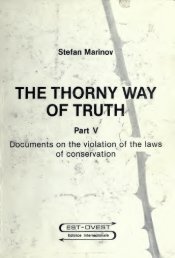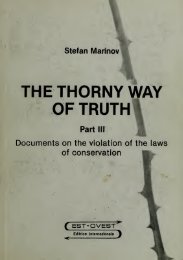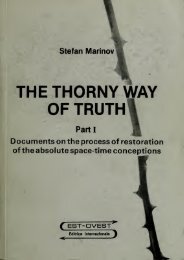The thorny way of truth - Free Energy Community
The thorny way of truth - Free Energy Community
The thorny way of truth - Free Energy Community
- No tags were found...
You also want an ePaper? Increase the reach of your titles
YUMPU automatically turns print PDFs into web optimized ePapers that Google loves.
2252. <strong>The</strong> referee knows (I presume) that the electric potential <strong>of</strong> a sphere charged homoeneously(in its volume or on its surface) with electric charges does not depend on theadius <strong>of</strong> the sphere (at any point <strong>of</strong> space outside the sphere). I showed in my paperhat the force acting on a topsyturvy U-form Ampere bridge does not depend on the radiusf curvature. It is thus CLEAR that the magnetic pushing force acting on a U-form Ampereridge will NOT depend on the thickness <strong>of</strong> the wire and it is CLEAR that the force on ALL-form Ampere bridges will be the same as that one calculated for an infinitely thin wire.In13.our world there are NOT "pulling" forces. When one goes through a door on whicht is written "pull", one PUSHES the door by one's hand in a direction OPPOSITE to one'slovement. But the force acting on the Ampere bridge is NEITHER a pushing force, as thempere bridge is a SELFPROPULSING object set in motion by INTERNAL FORCES, in a drasticiolation <strong>of</strong> Newton's third law and <strong>of</strong> all concepts <strong>of</strong> humanity about the forces accordingwhich alv/ays a body A acts on a body B. <strong>The</strong> Ampere bridge is a body A which ACTS ONTSELF.4. <strong>The</strong> edge forces are the forces acting on the wire elements with lengths ao at bothdges (corners) on the shoulder <strong>of</strong> the Il-form bridge. For a n-form bridge <strong>of</strong> an infinitelyhin wire the forces acting on these small current elements are INFINITELY BIG. <strong>The</strong> refeeecan read how Pappas, J. APPL. PHYS. 59, 19 (1985) (Pappas is the FIRST person who hasone QUANTITATIVE measurements <strong>of</strong> the forces acting on the Ampere bridge) evades in hisALCULATIONS and MEASUREMENTS the availability <strong>of</strong> these "edge forces".5. In my paper I do NOT compare theoretically calculated forces acting on the Ampereridge with experimentally measured forces, as I show that even for the MOST SIMPLE U-formridge the calculation leads to an improper integral, and I was UNABLE to establish MA-HEMATICALLY whether the integral is converting to a final number or to infinity. Thust has no sense to cite the numbers <strong>of</strong> different authors obtained for different n-formmpere bridges. (LATER - see this volume, p. 14) I found that the integral converges to infinity!)I do not know the measurements <strong>of</strong> Roper but, surely, this Roper, if he really doesxist, has not made some valuable measurements, as nobody <strong>of</strong> the scientists treatinghe "Ampere-bridge problems" in the last years makes reference to Roper. I shall be, howver,infinitely thankful to the referee if he will supply me with reference to Roper'sxperiments. Cleveland has done only QUALITATIVE but not QUANTITATIVE measurements <strong>of</strong>he forces acting on the Ampere bridge. Graneau, NUOVO CIMENTO D7, 31 (1986) and Peoglos,PHYS. D 21, 1055 (1988) obtain quasi the same number as Pappasf = 10"^ N/A^.All these authors search for different tricks to resolve in their experiments the probemwith the "edge forces".In my experiments (S. Marinov, THE THORNY WAY OF TRUTH, East-West, Graz, 1988 and 1989,art III, p. 74 and Part IV, p. 140) where the contact between the bridge and the wireshich are solid to the laboratory is realized by BALL BEARINGS, I foundf = (5 ± 2.5)xlO"^ N/A^.However I was UNABLE to calculate the force even on the MOST SIMPLE tupsytorvy U-formridge, as my mathematical abilities are LIMITED. Meanwhile a GOOD mathematician MUST BEIBLE to establish whether the first integral on the right side <strong>of</strong> formula (9) in my papers convergent to infinity or to a certain final number. <strong>The</strong> referee <strong>of</strong> PHYSICS LETTERSurely must be a GOOD mathematician and I do not doubt that he will be able to calculatehe integrals (9). I shall be infinitely thankful to him if he will do this. As the calcuationswill take some time, I shall gladly pay lim % 200 for the work. <strong>The</strong> money can beREPAID to the Editor <strong>of</strong> PHYSICS LETTERS in the case that the referee will promise to do;he job. (I repeat, LATER - see item 5 above - I found that the integral converges to infinity. )6. <strong>The</strong> "stick model" has absolutely no reference to the calculation <strong>of</strong> the force actingin a U-form Ampere bridge. <strong>The</strong> "stick model" is applied when there are conductors withINITE cross-sections. My conductors are with INFINITELY SMALL cross-sections. For morenformation, see A. Ludwig, IEEE Antennas and Propagation Society Newsletter, p. 40, Fe->ruary 1989, where there are many other references treating the above topics.








